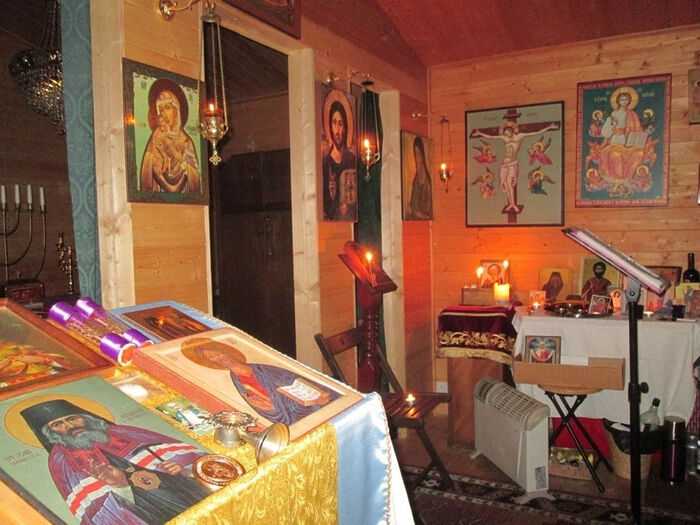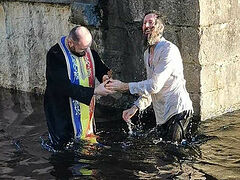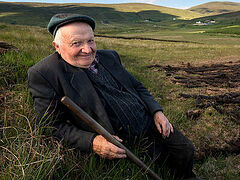The McBride family lives on Ashfield Street in a typical neighborhood of two-storied houses in north Belfast. Everything here is familiar to those who know British and Irish cities and their residential areas, the only difference being a birch tree planted many years ago that grows near the McBrides’ house. True, the capital of Northern Ireland is a specific city: it has seen a division between Catholics and Protestants (the Republicans and the Loyalists). At one time, the political and religious confrontation in Ulster brought all the horrors of hatred and curses, terrorist attacks and armed clashes that took the lives of over 3000 people.
From local residents’ point of view, the McBride family are Catholics, since the head of the family, Pat (Patrick), and his three sons belong to the Roman Catholic Church. However, the McBrides are not entirely part of the Belfast Catholic community, since Pat's wife, Johanna (Astrid), as well as their daughter Lucy, are Orthodox Christians.
Perhaps there is no single beaten path for those who were born outside the Orthodox Church and have found their way to the faith that gave the world St. Seraphim of Sarov, Holy Hierarch John of Shanghai, Sts. Job and Amphilochius of Pochaev and many other wondrous saints. Some people, after learning about Orthodoxy, convert to the true faith very quickly; sometimes after several months. But for others this journey takes many years, accompanied by painful reflections, sometimes sorrow and long, heartfelt prayer. Motivations can vary—from disappointments and intellectual searchings to marriage with an Orthodox Christian.
 At the Church of St. John of Shanghai in Belfast. Fr. Paul Elliott from Birkenhead celebrates Astrid Keil (her surname before marriage), who now lives in the north of Belfast, wasn’t born on Irish soil, but in Germany, to a Protestant family. From childhood she was raised in Lutheranism, in which there is no veneration of the Theotokos and the saints. Paradoxically, Astrid’s first encounter with Orthodoxy was in her own Lutheran family. Her father, a professor of Slavonic studies, enjoyed listening to Orthodox hymns when he wanted to rest mentally and spiritually. The little girl really liked Orthodox hymns—sometimes she listened to them without her father’s knowledge, entering his room unnoticed. These touching and pleasant childhood memories remained in her heart forever.
At the Church of St. John of Shanghai in Belfast. Fr. Paul Elliott from Birkenhead celebrates Astrid Keil (her surname before marriage), who now lives in the north of Belfast, wasn’t born on Irish soil, but in Germany, to a Protestant family. From childhood she was raised in Lutheranism, in which there is no veneration of the Theotokos and the saints. Paradoxically, Astrid’s first encounter with Orthodoxy was in her own Lutheran family. Her father, a professor of Slavonic studies, enjoyed listening to Orthodox hymns when he wanted to rest mentally and spiritually. The little girl really liked Orthodox hymns—sometimes she listened to them without her father’s knowledge, entering his room unnoticed. These touching and pleasant childhood memories remained in her heart forever.
Astrid's childhood with its joyful “musical” encounter with Orthodoxy gave way to youth, and at the age of fifteen she encountered Orthodoxy again—now at a religious and liturgical level. A Greek Orthodox church was built in the area of Bonn where the Keils lived. The Greeks invited local Catholics and Protestants to the Paschal night service. Rolf-Dietrich decided to go to the festive service with his daughter.
“For me these were unusual, incomparable impressions,” Johanna relates. “I felt elation and joy. Everyone in the church spoke Greek. I didn’t understand them, but I saw joyful faces and positive emotions. One woman even hugged me—she was so happy on the feast of the Resurrection of Christ, and she wanted to share her happiness and joy with me.”
 At the Church of St. John of Shanghai in Belfast
At the Church of St. John of Shanghai in Belfast
The joy of the encounter, the feeling of Christ's presence, kind emotions, the benevolence of unknown parishioners... It seemed that all conditions were interwoven for the young Lutheran woman to set foot on the path to Orthodoxy. But that didn’t happen. The Paschal service and emotions became a thing of the past. Astrid no longer went to services at the Greek church. It was necessary to wait for something else; apparently as a Protestant she needed to go through a special acceptance of the image reflecting the prototype—the Orthodox icon—in her religious search. For many Protestants, the veneration of icons was and still remains one of the stumbling blocks, which, alas, prevents them from coming closer to Orthodoxy. Even with sympathy for the deep theological sophistication and moral teachings of the Orthodox Church Fathers, Protestants sigh with doubt when they see burning candles in front of icons of the Most Holy Theotokos or St. Sergius of Radonezh. It is very difficult to overcome this stereotype of Protestant consciousness, especially when many generations have absorbed Protestant logic and dogmatics from childhood.
And again a miraculous encounter came through her family: Rolf-Dietrich brought two large posters about an icon exhibition from Moscow. On one of them there was an image of an icon of the Most Holy Theotokos, and on the other one, of St. John the Baptist. Surprisingly, these images, printed on paper, somehow resonated in the heart of the young Lutheran woman: She began to pray secretly in front of them.
“You see, I didn't know anything about holy icons,” Johanna continues. “I saw that one icon depicted the Virgin Mary, but as for the second one, at first I wasn’t even sure whether it was Christ or St. John the Baptist. Nevertheless, I began to pray in front of these icons. I had the feeling that St. John the Baptist was holding out his hands as if he wanted to receive thoughts and words addressed to him. I felt that I could share my desires, feelings and thoughts with him. Moreover, when I looked into his eyes, I felt how they was leading me to prayer.”
From that moment on, Astrid could no longer imagine her life without Orthodox icons. Another miracle followed in due course: through the icon of St. John the Baptist she received a revelation about her future daughter! According to Johanna, in 1996, when they were already raising three children, she caught herself thinking that God wanted to send them another child. During prayer Astrid saw a small image of a praying girl appear on St. John the Baptist’s icon. To dispel her doubts she called her husband. But Pat saw the same thing!
Nine months later, another Christian soul came to our world... A whole book (in English) is devoted to this story: Anne-Marie... a Child of God, in which there is an account of this miracle, and of the ordeals endured by the little girl during her short life (Anne-Marie didn’t live more than three years; she died during a second heart operation).
Since the news of her daughter’s birth came through an icon that had arrived from Russia, Astrid decided to find a Russian church and talk to the priest there.
 Pat and Johanna with little Anne-Marie “I didn't want to go to a Romanian or Greek church because the icon was Russian,” Johanna recounts. “The nearest Russian parish was at Stradbally (a town in county Laois in Ireland’s midlands, southwest of Dublin, about 160 miles From Belfast). I talked to the priest there, and to some extent he agreed with me that Anne-Marie, whose birth I was expecting, should be baptized in Orthodoxy. But there were no Orthodox Christians in our family, so the bishop to whom the priest turned for advice decided that Orthodox Baptism for my daughter was possible if one of the parents became Orthodox. At that time I was Lutheran and my husband was a Roman Catholic. Therefore, we baptized Anne-Marie in the Catholic Church.”
Pat and Johanna with little Anne-Marie “I didn't want to go to a Romanian or Greek church because the icon was Russian,” Johanna recounts. “The nearest Russian parish was at Stradbally (a town in county Laois in Ireland’s midlands, southwest of Dublin, about 160 miles From Belfast). I talked to the priest there, and to some extent he agreed with me that Anne-Marie, whose birth I was expecting, should be baptized in Orthodoxy. But there were no Orthodox Christians in our family, so the bishop to whom the priest turned for advice decided that Orthodox Baptism for my daughter was possible if one of the parents became Orthodox. At that time I was Lutheran and my husband was a Roman Catholic. Therefore, we baptized Anne-Marie in the Catholic Church.”
But her interest in and respect for Orthodox icons never ceased to bear fruit. In the Church of St. Colman in Stradbally (ROCOR) Astrid noticed an icon of St. John of Shanghai and San Francisco. She seemed to feel the special presence of this saint there. And again it was a paradox: Astrid refused the priest's offer to embrace Orthodoxy, believing that Orthodoxy was open to Anne-Marie but not to her. It was obviously very hard for a Lutheran woman to embrace an unfamiliar, “foreign” faith, especially when no one in her family belongs to this faith. It took a while before Astrid’s inner convictions allowed her to begin preparations for Orthodox Baptism. She was a catechumen for over two years, beginning December 2000. And only in January 2003 was Astrid baptized in Orthodoxy with the name Johanna. The Baptism was performed in the Jordan River during her stay at the convent of Mt. of Olives in Jerusalem, where there is also a chapel of St. John the Baptist.
“There I made friends with one of the nuns, Sister Seraphima, and she came to visit us in Northern Ireland,” Johanna says. “At that time a new trial awaited us: Our son Pascal was diagnosed with cancer at the age of eleven. Nun Seraphima, who had a small portion of St. John of Shanghai’s vestments with her, gave us half of it. My son and I prayed in front of St. John’s icon for healing. By the way, Pascal confessed to me that while the doctor was speaking to him about his illness, he felt the presence of the Savior in the hospital ward. By the grace of God and through the prayers of St. John of Shanghai my son recovered, and we (taking his younger brother with us) went to San Francisco to thank the saint for his help.”
As Johanna recalls, in that California city, where the amazing Russian saint lived for many years, she really wanted to tell someone about the miracle of healing. She shared this with the monk who later showed her the house where St. John had lived, his office, the church where he often served, and the icon in front of which he prayed, offering up his petitions for orphans transported from China to the United States. That pilgrimage became an unforgettable joyful experience. When Johanna, Pascal and his younger brother returned to Belfast, the first thing the five-year-old boy exclaimed as he hugged his father who met them at the airport was, “Dad, I saw St. John!”
McBride family has bee marked with miraculous and amazing events, but this hadn’t yet brought them all to Orthodoxy. As Johanna points out, “I can’t force them. My eldest son says that Orthodoxy is the right faith, but there is also a road to this faith.” Surprisingly, Johanna’s only surviving daughter Lucy was the first among her children to convert to Orthodoxy—at the age of eight. The girl was very impressed by one of the family’s guests, priest Andrei Logvinov, who as Johanna said, “didn’t take a leave of absence from Christianity for a single moment; he was like a saint.” After talking with Fr. Andrei, Lucy told her mother (at the age of seven) that she would like to become an Orthodox nun! Of course, that childhood desire remained in the past, but the true faith of Christ entered Lucy’s life—through her familiarization with the Orthodox Church.
 Johanna and Pat McBride with children
Johanna and Pat McBride with children
Now Lucy, like Pat’s and Johanna’s three sons, lives separately from her parents. So far only the female part of the McBride family has converted to Orthodoxy. The men remain Catholics despite their respect for the Orthodox Church. Will they embrace Orthodoxy in the future? We don’t know. But it is not easy for the Irish (especially from Ulster) to leave Catholicism and join the Church of the first Christians and apostles, even if they are convinced that the fullness of Christ shines in it. Incidentally, Johanna's parents departed this life as Lutherans, although her mother came to love St. John of Shanghai in a special way and even made the sign of the cross (for the first time in her life) in front of his icon a few moments before her death (which coincided with the feast of St. John).
After working in the British National Health Service for many years and then retiring, now Johanna carries out her missionary service at the Church of St. John of Shanghai, located (since November 2017) in the courtyard of the McBrides’ house on Ashfield Street. ROCOR clergy who travel from England celebrate the Liturgy here, usually once a month. On other Sundays, the typika is read by laypeople. The language of services is English, which is certainly convenient for parishioners of different nationalities and for local residents who are interested in Orthodoxy. It is gratifying that Johanna, having made the difficult journey from Lutheranism to Orthodoxy, has become not only a parishioner, but also an active organizer in the life of the parish community. In her service there is also help for those seeking to embrace Orthodoxy or wishing to learn more about the faith that gave our world many wonderful saints, including John of Shanghai and San Francisco, now glorified on Irish soil in a church bearing his name.






